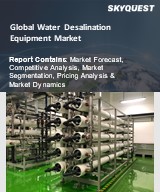
Report ID: SQMIG55D2022

Report ID:
SQMIG55D2022 |
Region:
Global |
Published Date: May, 2024
Pages:
182
|
Tables:
91 |
Figures:
76
Drivers
Rising Water Scarcity
Geographical Factors
Climate Change
Restraints
Lack of Proper Wastewater Disposal Planning
Limited Production of Freshwater and High Initial Costs
Our industry expert will work with you to provide you with customized data in a short amount of time.
REQUEST FREE CUSTOMIZATIONWant to customize this report? This report can be personalized according to your needs. Our analysts and industry experts will work directly with you to understand your requirements and provide you with customized data in a short amount of time. We offer $1000 worth of FREE customization at the time of purchase.

Report ID: SQMIG55D2022